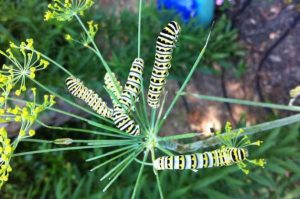Butterfly Host Plants
What is a Host Plant for Butterflies
A plant that gives butterflies shelter required for laying eggs and serves as a food source to their caterpillars is called a host plant. Flowering plants such as Passion Vine and Milkweed, herbs like Fennel, and trees such as Sweet Bay Magnolia are all used as host plants.
Common Butterflies and their Host Plants
Creating a list of host plants is the first step towards planning a butterfly garden. Since different plant species attract different butterflies, you need to choose the right host plants for the survival of caterpillars. You should have a mixture of host plants and nectar-rich flowering plants if you want to increase the variety of butterflies in your landscape. Some nectar-producing plants include butterfly weed, milkweed, butterfly bush, ironweed, asters, verbena, common zinnia, Mexican sunflower, tickseed sunflower, Brazilian vervain, and chaste tree.
Here we have listed a few host plants that will attract some of the more common butterfly species to your garden.
| Butterfly Species | Host Plant |
| Alfalfa Butterfly | Clovers, alfalfa, deerweed |
| American Copper | Curly dock, sorrel |
| American Lady | Ironweed, pearly everlasting, pussytoes |
| American Snout | Hackberry |
| Anise Swallowtail | Citrus, parsley, fennel, anise |
| Atala Butterfly | Coontie |
| Black Swallowtail | Fennel, carrot, parsley, dill |
| Banded Hairstreak | Walnut, hickory, oak |
| Baltimore Checkerspot | Turtlehead |
| Buckeye | Toadflax, plantain, snapdragon, gerardia |
| Cabbage White | Brussels sprout, collard, mustard plant |
| California Dogface | Blue false indigo |
| Carolina Satyr | Grass |
| California Sister | Oak |
| Checkered Skipper | Hollyhock, mallow |
| Checkered White | Tumble mustard |
| Clouded Sulphur | Clover, alfalfa |
| Cloudless Sulphur | Senna, canary bird bush |
| Colorado Hairstreak | Oak |
| Common Snout | Hackberry |
| Diana Fritillary | Violets |
| Dogface | False indigo, clover, lead plant |
| Dreamy Duskywing | Aspen, willow, poplar |
| Dotted Checkerspot | Beardtongue |
| EasternTailed-blue | Wild pea, alfalfa, clover |
| Eastern Comma | Hop,elm, nettle |
| Eastern Tiger Swallowtail | Willow, sycamore |
| Giant Swallowtail | Rue, citrus, prickly ash, hop tree |
| GrayHairstreak | Clover, hawthorn, mallow |
| Gulf Fritillary | Passion vine |
| Horace’s Duskywing | Scrub, white, and red oaks |
| Marine Blue | Legume, alfalfa |
| Karner Blue | Legume, lupine |
| Mourning Cloak | Alder, elm, cottonwood, poplar, willow |
| Oregon Swallowtail | Parsley, sagebrush |
| Orange Sulphur | Clover |
| Painted Crescent | Aster |
| Pipevine Swallowtail | Pipevine |
| PearlCrescent | Aster |
| Painted Lady | Hollyhock, legume, thistle, mallow |
| QuestionMark | Elm, falsenettle, hackberry, nettle |
| Queen | Milkweed |
| Red Satyr | Grass |
| Red Admiral | Hop, admiral |
| Red-spotted Purple | Poplar, oak, cottonwood, willow, cherry |
| Red-bandedHairstreak | Oak, waxmyrtle, sumac |
| Regal Fritillary | Violet |
| Sandia Hairstreak | Beargrass |
| Sachem Skipper | Grass |
| Silver-spotted Skipper | Locust, false indigo |
| Satyr Comma | Nettle |
| Spicebush Swallowtail | Sassafras, spicebush |
| Summer Azure | New Jersey tea, flowering dogwood |
| Spring Azure | Blackcherry |
| Two-tailed Swallowtail | Hop, ash, chokecherry |
| Tawny Emperor | Elm |
| Viceroy | Poplar,cottonwood, willow |
| Zebra Swallowtail | Paw-paw |
Aside from host plants and nectar-rich plants, you may offer a fruit-feeding station, because some species like the monarch, mourning cloak, question mark, and red-spotted purple, feed on fruits. Therefore, you need to diversify your offerings for attracting more of these beautiful butterfly species.




